Kao Thom — Thai Porridge
- Pease porridge hot, pease porridge cold,
- Pease porridge in the pot, nine days old;
- Some like it hot, some like it cold,
- Some like it in the pot, nine days old.
Like most kids, I repeated the nursery rhyme and clapped away with my hands without having any clue what the heck porridge was.
When I was a little older, I remember a teacher describing it to me as gruel that was eaten during the Middle Ages. Doesn’t sound very appetizing, I remember thinking. Even the name, gruel, sounds awful.
Webster’s defines porridge as a soft food made by boiling the meal of grains or legumes in milk or water until thick, and its origins date back to circa 1643.
According to Wikipedia, other grain meals boiled in water, such as cornmeal, may also be described as porridge, but more frequently have other names, such as polenta or grits. Oat and semolina porridge are the most popular varieties in many countries. In addition to oats, cereal meals used for porridge include rice, wheat, barley and corn. Legumes such as pease meal can also be used to make porridge. Porridge was a traditional food in much of Northern Europe and Russia back to antiquity.
When I think back to my years in Thailand, I remember getting up for the weekend breakfasts at my uncle’s house after staying up till all hours of the night with my cousin Ronnie. His father would shout up at us from the dining room that breakfast was ready. W e would crawl out of our futons onto the cool cement floor, crawl on hands and knees until we reached the stairs, then we would reverse ourselves and, still on all fours, crawl backwards down the stairs, racing each other to get to the bottom.
By the time we got to the dining table, a round table with a lazy susan in the center, there was a simple meal of kao thom (rice soup) waiting for us with several side dishes including sweet pickled cucumbers, pickled cabbage, salted preserved duck eggs, a sour salad of dried shrimp, chicken livers fried in ginger and soy sauce, fried dace (a type of freshwater fish) with black bean sauce, and a spring onion omelet. So it turns out even Thais have a version of porridge.
To this day, it’s a comfort food that we enjoy at our home. Except we often will eat it for dinner instead of breakfast. I refer to it now as porridge. My mother’s version is slightly different than the one I remember at my uncle’s house. She’s a traditionalist when it comes to Thai meals: a salty dish, a savory dish, a sweet dish and a sour dish. Her sides to go with kao thom include sweet Chinese sausage, the familiar spring onion omelet but with ground pork added, sweet pickled cucumbers, pickled cabbage, and a sour salad of dried shrimp. I’m grateful for no salted preserved duck eggs as I never really took to them. I have a feeling Mom likes them, though, because I will often spy some in the refrigerator in the garage.
Everyone has their favorite comfort food. It’s the thing that warms you up when you’re sick. Or when you’re out of sorts, it’s the thing that brings back a nice memory connected with the food.
We should all make time for comfort food. Even when we’re not sick. Just so that we can nourish ourselves periodically with those pleasant memories from our childhood. In my case, a close relationship with a cousin and best friend who is half a world away now, and a favorite uncle who is no longer alive.
I continue my mother's tradition of kao thom. Clockwise from top left: sweet pickled cabbage and sweet pickled cucumbers, spring onion omelet, Thai rice porridge, dried shrimp salad, fried Chinese sausage.
Charles’ favorite side dish with kao thom is the spring onion omelet. Mine is the sour salad of dried shrimp. It turns out I have a real sour tooth. My mother says it’s because when she was pregnant with me, her morning sickness was so bad that the only thing she could eat were sour fruits or pickled fruits.
Go figure.
Pickled cabbage and pickled cucumbers can be found in cans sold at most Asian grocery stores. All you have to do is open the can and serve them. The rest of the sides require some work, so here are their recipes if you ever want to try this very traditional Thai comfort food.
Fried Chinese Sausage
- 3 or 4 links of Chinese sausage
- 2 tablespoons (30 ml.) cooking oil
- In a non-stick pan, bring 2-4 cups (480-960 ml.) of water to a boil (enough to cover the sausages).
- Separate the sausage links from each other, place in the boiling water and cook for 5 minutes.
- Remove the links, drain the water from the pan, wipe pan dry, put back on stove over medium heat and pour in cooking oil.
- Add the sausage links to the pan and fry until their color darkens to a deep mahogany. You’ll want to move the sausages around by moving the pan back and forth over the burner and rolling the sausages around in the pan so that they don’t burn. The sausages have sugar in them so they will burn quickly if you’re not careful.
- Remove sausages and slice into thin pieces on the diagonal and place in serving dish.
Spring Onion Omelet
- 4 large eggs
- ¼ lb. (113 g.) ground pork
- 3 spring onions, finely sliced
- Ground pepper to taste
- 1 teaspoon (5 ml.) fish sauce, or you can substitute soy sauce or salt
- 2-3 tablespoons (30-45 ml.) cooking oil
- Beat eggs lightly in a bowl until yolks and whites are combined.
- Add fish sauce (or soy sauce or salt) and ground pepper and mix in with whisk.
- Add ground pork and, using the whisk, break up the ground pork so that there are no large pieces.
- Add spring onions.
- Heat oil in a non-stick pan over high heat.
- Add the beaten egg mixture and cook 3-4 minutes before flipping the omelet. Cook another 3-4 minutes and check for doneness. You may need to flip it again and cook each side another minute or so if the pork doesn’t look done.
- Remove from pan, cut into wedges and serve.
Cans of pickled cucumber, Chinese cabbage and a package of dried shrimp. You can find these ingredients at most Asian grocery stores.
Dried Shrimp Salad
- 1 cup (240 ml.) dried shrimp
- The juice from 1 lime
- 1 tablespoon (15 ml.) fish sauce
- 2 tablespoons (30 ml.) water
- 1 tablespoon (15 ml.) sugar
- 1 tablespoon (15 ml.) finely sliced shallot
- 1 tablespoon (15 ml.) ginger, peeled and sliced into thin strips
- 1 Thai red pepper, cayenne pepper or jalapeño pepper, sliced into small pieces
- Soak the dried shrimp in very hot water for 10 minutes, then rinse and put in serving bowl.
- Melt the sugar in the 2 tablespoons (30 ml.) of water and add to the shrimp in the bowl.
- Add lime juice, fish sauce, sliced ginger, peppers, and shallots.
- Mix well and serve.
Rice Porridge
- 2 cups (480 ml.) Thai jasmine rice
- 6 cups (1.5 lt.) water
- Place rice in a medium-sized pot and rinse several times with cold water. Empty as much of the rinsing water as you can without pouring the rice out of the pot.
- After the rice is rinsed, add 6 cups (1.5 lt.) water and bring to boil over high heat. Stir the rice in the boiling water to make sure it doesn’t stick to the bottom of the pot.
- Lower the heat to medium and simmer for 10 minutes uncovered.
- Turn off flame and cover. Let stand for 10 minutes before serving. The rice will swell and absorb much of the water but it should still have a soupy consistency.
- Serve with above side dishes and the pickled cucumbers and pickled cabbage.
Enjoy our simple Thai comfort food and create some happy memories of your own.
— Vic
Category: Thai
About the Author (Author Profile)
Victor Panichkul is a journalist and writer by training; a cook, wine lover and photographer by passion; and a lover of the outdoors since moving to Oregon more than 10 years ago. He is a native of Bangkok, Thailand.






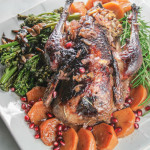

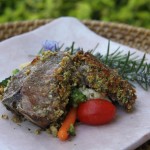



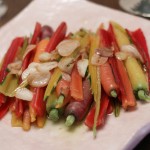
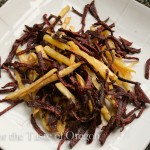


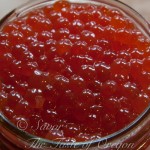


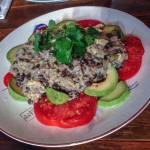

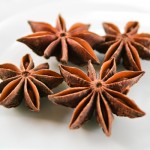



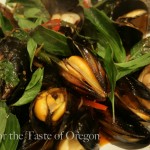



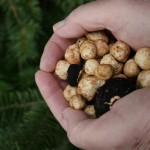




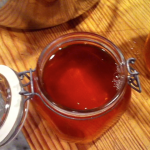











I also like the dried shrimp which surprised me. I miss the dace canned with the fermented black beans which had a “chocolaty” flavor. We haven’t seen the dace with the bean sauce recently. Probably something to do with international trade or falling out of favor with a distributor. Who knows?